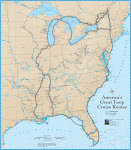 |
| Our tour guide showing a chair from the period when Flagler College was a hotel. The chair has wheels on the front to make it easier for the gentleman to push the lady closer to the table. Our guide is a student at the college, a private liberal arts college which was in the beginning (1968) a ladies' college. As of the early 1970s it has been co-ed, but she says there are still 3 females for every male. The original hotel is dining hall, a few offices, and ladies' residence. |
 |
| These pillers support the balcony around the second story; the carvings on four sides depict a woman in different stages of pregnancy. The guide said that the woman's face looked grumpier as the pregnancy progressed, but I couldn't see it. |
So much to see; so little time! We went on one of the hop on hop off tours today. Good chance to see the town and hear something of its history, and it was worth while doing. Went back to Flagler College for a tour; Flagler college was one the Ponce de Leon Hotel and it is magnificent. It has the world's largest collection of tiffany glass. The interior is filled with carvings and paintings, reminds me of some of the huge palaces and museums in Europe. The student dining hall was the dining room of the hotel, and WOW!! It is beautiful. When the hotel first opened, it was open for the winter season only, from January to March. Rooms cost anywhere from $6. to $90. per night, but you had to pay for the whole season, no matter how long you actually stayed. In the dining hall, Henry Flagler had a table at one end. The important people had tables near his, then the people paying more were closer to him than those paying less. Those paying only $6. per night were at the other end of the dining room. The many carvings and paintings in the hotel/college represent the Spanish influence on the area, as well as Flagler's religious faith (his father was an iterant Presbyterian preacher), and he himself built the Presbyterian Church here in St. Augustine as a memorial to his daughter who died following childbirth.
From there we toured the Spanish hospital museum. It recreates hospital care for the sick and wounded soldiers in the late 1700's. In fact, at that time, walls and floors were washed daily, as were the patients and the bedding. Doctors washed hands between every patient. It was much later than that when British care was as concerned with cleanliness (took Florence Nightingale to teach them). It seems to have stopped working tonight. The harbourmaster told us that they have just renovated the bridge at a cost of $60 million dollars. It apparently worked fine before the renovation, but now stops about once a week. For the past couple of hours, we have watched them stop traffic, ring the bells, boats come up to the bridge, then nothing happens. After a few minutes, they riase the bars and allow traffic to go through again. Then a while later, the process happens all over again. So far, the bridge has not risen. It is about 27 ft high, so any boat higher than that has to wait. There are a couple of tour boats from here caught on the other side of the bridge; a little boat from the marina here has been going out taking people off the tour boats. That has been our entertainment for the evening.
 |
| Part of the ceiling of the entrance to Flagler College |
 |
| Sign above the elevator in Flagler college, one assumes gentlemen are not welcome in the ladies' rooms. |
 |
| One of two towers at Flagler College, originally built to store water. This hotel had hot and cold running water, electric lights installed by Edison (2nd building in the US to have electric lights). |
St. Augustine is a great place with a lot to see so we will probably stay here another day.







No comments:
Post a Comment